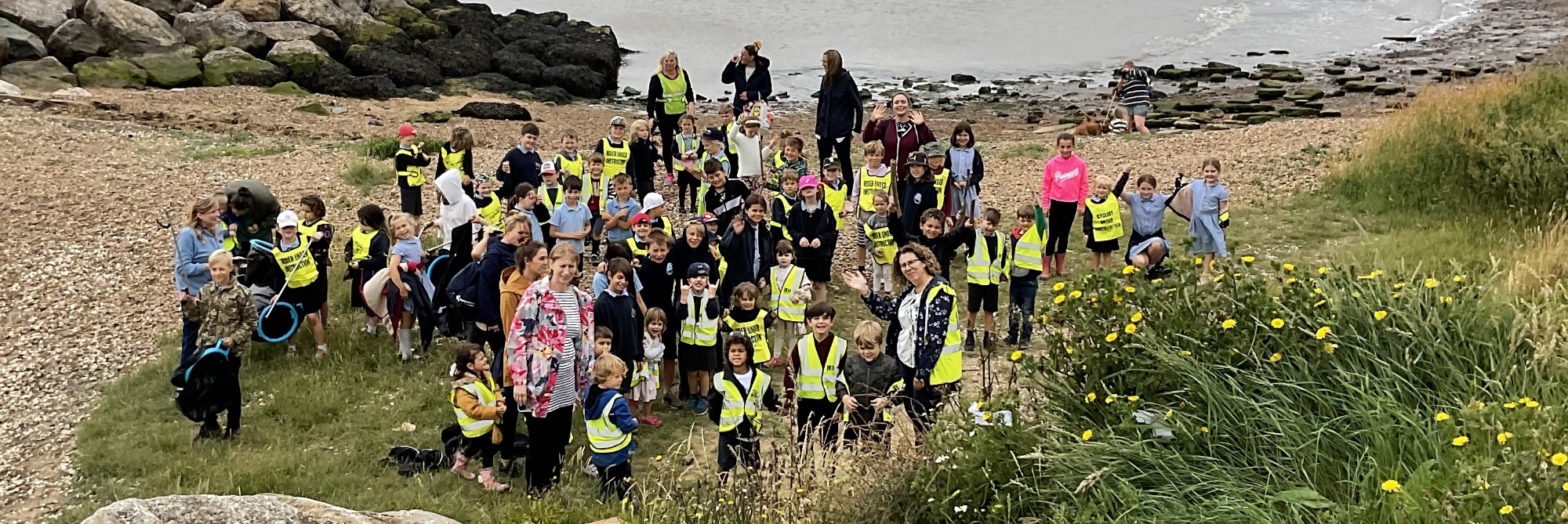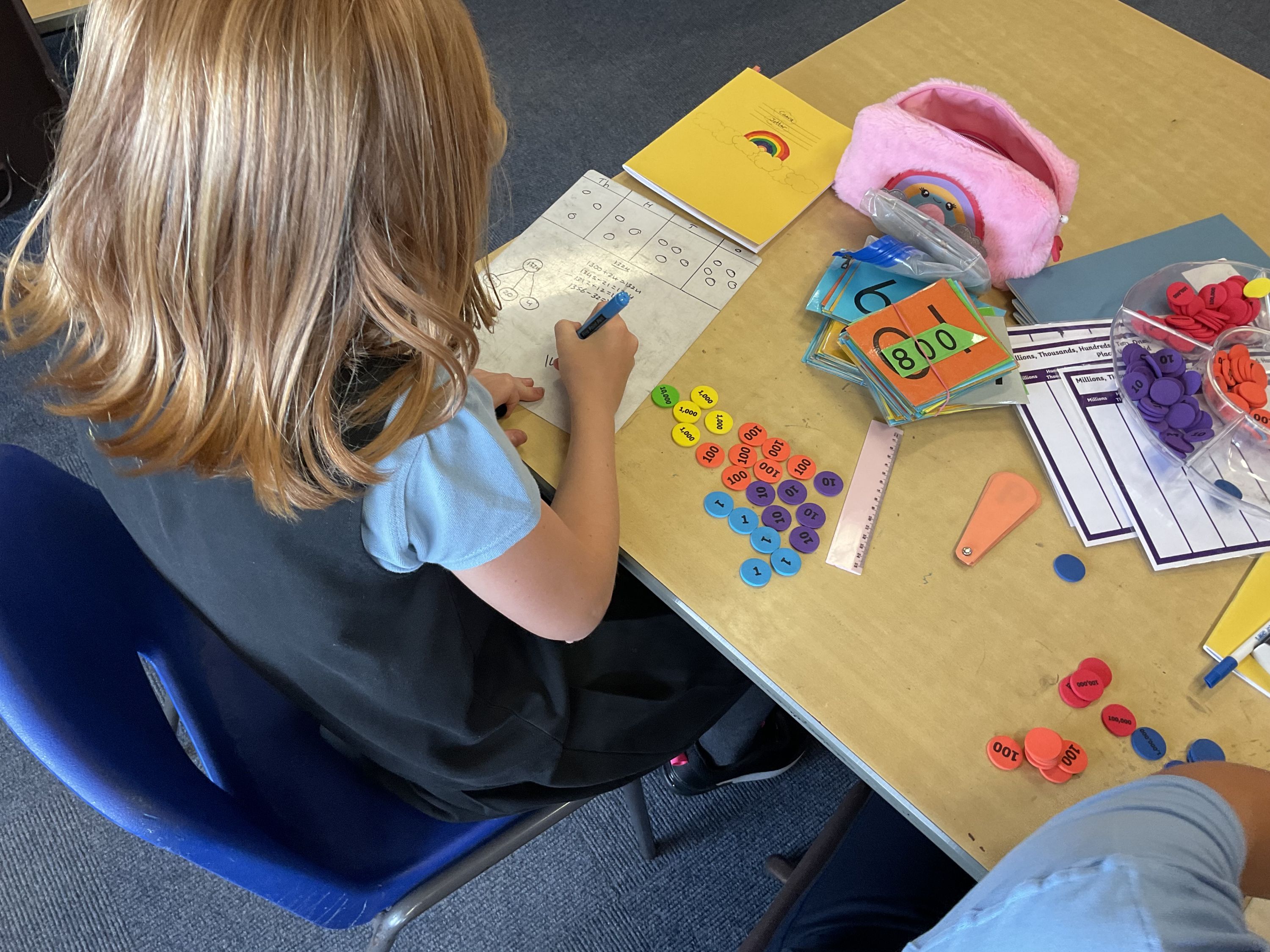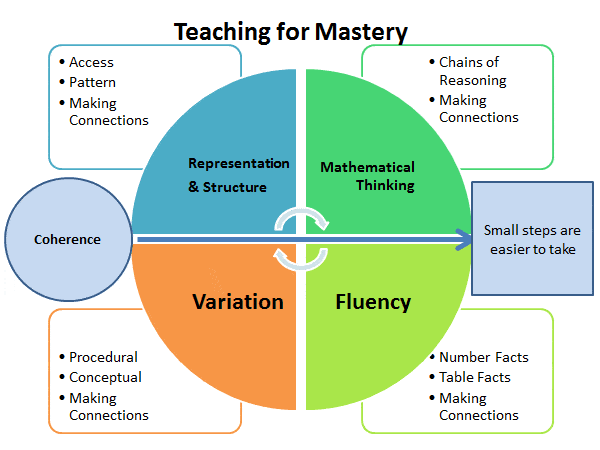Our unique curriculum
Introduction
The School aims to provide the children with an interesting, balanced, stimulating and varied curriculum, and all areas of the National Curriculum are incorporated. We have planned for the children to have five vision aims to be followed within different curriculum areas. The intent is that they are woven throughout the children's education as quintessential golden threads to help them develop as global citizens, The aims are to be Caring, to enjoy and seek out Exploration, to be Courageous, to understand Equality and that they are equal with others and have the Resilience to flourish and thrive in their lives.
The curriculum topics have been carefully planned on a long-term basis, so that each child in their seven years follows a progressive programme of work: developing concepts, knowledge, skills and understanding provide children with the confidence to play their full role in society.
High standards are established in all curriculum areas, and Bawdsey's small class sizes enables us to provide a carefully personalised programme which allows all abilities of children to achieve their potential. Equal opportunities for all, regardless of any difference, is important at Bawdsey School.
'The school’s values are threaded into the broad and balanced curriculum which includes experiences and trips to further ensure the rounded development of each child. Learning includes the use of ‘big questions’ which is fuelling pupils’ curiosity and increasing their confidence. The headteacher ensures that all pupils have learning opportunities through beach school. They use their local environment, including the beach, to develop their appreciation and care for God’s world. The higher than average proportion of vulnerable and SEND pupils thrive at this small school because no challenge is seen as a barrier to learning or progress.' SIAMs report March 2020.
How our Vision links to our Curriculum: Curriculum Vision
The complete 'Learning and Teaching Curriculum' document to download- or read as subject sections below.
Our Classes' Curriculum 2024-2025 for Foundation Subjects- Our two year rolling plan 2023-2026 for Foundation Subjects.
Cycle BMaths 2024-2025 plan - Please click on the year for the document. |
Cycle AMaths 2023-2024 plan - Please click on the year for the document. |
Rec and Nurs | Year 1 and 2 | Year 3 and 4 | Year 5 and 6 | |||||
Cycle BEnglish 2024-2025 planWriting and Comprehension |
Rec and Nurs | Year 1 and 2 | Year 3 and 4 | Year 5 and 6 |
Cycle AEnglish 2023-2024 planWriting and Comprehension |
Rec and Nurs | Year 1 and 2 | Year 3 and 4 | Year 5 and 6 |
Adapting our curriculum to utilise our local area and places of interest:
We have also adapted our curriculum to use resources and places of interest in the local area that are available to us at Bawdsey CEVCP School. Like our proximity to Bawdsey Radar, The Suffolk Punch Trust, Sutton Hoo, local farms and farmers, East Lane and Bawdsey quay, Bawdsey Church, Orford and Framlingham castles, the rivers Deben and Orwell and Ipswich Museum. Please see when we will be linking to these special places on our two-year curriculum plan above.
English & Literacy
For English and Class reading we use the Literacy Tree resources. 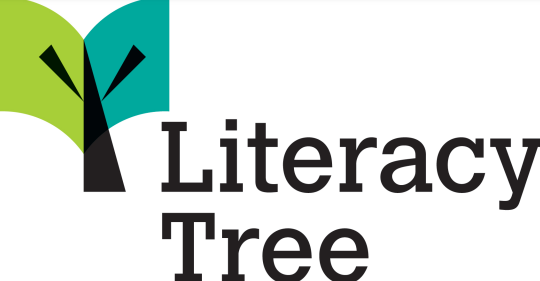
Literacy has high priority and gives the basis to all learning in the school. Emphasis is put on children speaking clearly and gaining confidence to speak to various audiences; to listen to others and to respond appropriately to instructions, stories, poems and information. All children are taught to participate in general discussion and drama. We aim to establish positive lifelong attitudes to reading, ensuring that children find pleasure and that skills are developed to each child's full potential. We are currently working with the Booktrust to further develop this love of reading.
The school has a continually developing classified non-fiction library for all children to use. Every classroom has a wide range of fiction books and texts which are used for class and group work. We have recently introduced ‘The Literacy Tree’ into KS1 and KS2, which one book is focused upon, and the lessons explore the text in depth. This allows for Literacy to be integrated into other lessons and for topics to become cross-curricular.
Early years have the ‘Little Wandle’ phonics scheme. For more information please see the Phonics information below.
Parents/ Carers, children and teachers are encouraged to make comments regarding reading in the Home / School Log Book. Children are encouraged to read every day at school and at home.
Links to
The Literacy Tree English policy statement
The Literacy Tree steps in progression document
English 2024-2025 planCycle B Writing and Comprehension- please click on the year for the document. |
Rec and Nurs | Year 1 and 2 | Year 3 and 4 | Year 5 and 6 |
English 2023-2024 planICycle A Writing and Comprehension- please click on the year for the document. |
Rec and Nurs | Year 1 and 2 | Year 3 and 4 | Year 5 and 6 |
|
Intent: Our English curriculum promotes and facilitates spoken and written fluency, ensuring that pupils have the skills and confidence to communicate their ideas and emotions in a variety of ways. Reading fuels development in all other aspects of language ability and skill. It enriches pupils culturally, emotionally, intellectually, socially and spiritually. Engagement with high quality contemporary and classic literature is integral to this endeavour. Through reading, pupils are able to acquire knowledge, make connections and further build on what they know. For pupils to engage fully in society, it is essential that they develop fluency in literacy. Fluency and confidence in written and spoken communication support the development of knowledge and skills across all other areas of the curriculum. Literacy Leaves intent We believe the exposure of children’s literature within the primary school setting is vital as a rich context for learning; not only within English as a subject but to support building a reading culture throughout the school. We aim to use high quality books that offer opportunities for empathy and can aid philosophical enquiry, as a means of developing the spoken language requirements through debate, drama and discussion using the issues raised through, and within, the text. |
|
Implementation: Learning and teaching across the English curriculum are delivered with the support of the following programmes and resources: Little Wandle and the Literary Tree Curriculum. English lessons are taught and planned as sequences of lessons based on ‘expertly-chosen, quality children’s books’ that promote high levels of engagement with the text. A range of reading, writing and speaking/listening opportunities are provided over the course of a sequence of lessons that can last between two and five weeks. These sessions are complemented by small-group phonics sessions in KS1 (following the Little Wandle programme), regular handwriting (sessions using the Nelson Handwriting Scheme), additional spelling sessions, focused grammar-based tasks and regular opportunities for sustained independent reading to foster fluency, stamina and enjoyment of reading. While a range of skills are developed outside of English lessons, careful planning and delivery ensure that they are applied and consolidated in the context of both English lessons and opportunities to write at length in other curriculum areas. Fluency, technical accuracy and creativity are key foci in all written and verbal communication. |
|
Impact: Our intended impact is that:
Children will leave Bawdsey CEVC school with a confident, fluent handwriting style and pace. |
|
A typical lesson contains:
|
Phonics
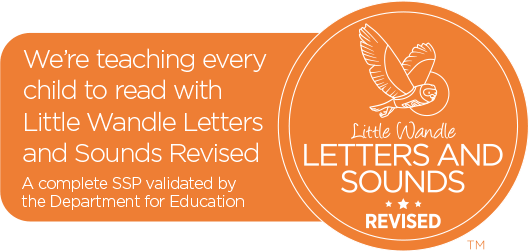 We are a LITTLE WANDLE SCHOOL!
We are a LITTLE WANDLE SCHOOL!
https://www.littlewandlelettersandsounds.org.uk/resources/for-parents/
The following link also provides an overview of the Learning to Read Journey for those in Reception and Year 1. https://www.littlewandlelettersandsounds.org.uk/wp-content/uploads/2021/12/Programme-Overview_Reception-and-Year-1-1.pdf
In order to have fun with our new approach and inspire every child to read, we will be embarking on a new whole school reward system for reading. There is a minimum requirement that all children should read at home 6 times per week, recorded and signed in Reading Records. This can be a shared reading experience in Reception, working up to a 10-minute independently read chapter for Year 6!
Please find attached some information about how you can engage with your child at home to give them a head start in life.
As a school, we are committed to providing opportunities for your child to Read for Pleasure. We have Whole Class Shared Reading during the week with an hour session at the beginning of the week as part of our curriculum, and 2 x 30 min sessions throughout the remainder of the week. These sessions are a chance to access a high quality text, with a focus on reading skills and comprehension. We use ‘Reading VIPERS’ in Key Stage 1 and Key Stage 2 for the key reading skills which are Vocabulary, Infer, Predict, Explain, Retrieve, Sequence. Please see the attached handout for more details.
Your child will also have the opportunity to read to another reading volunteer in school, as well as Class Teacher and/or Teaching Assistants. We also encourage independent reading, and also the reading involved across the curriculum during daily teaching and learning.
Link to a Letter and Sounds Phonics and Early Reading Policy
|
If you have any questions about ‘ Little Wandle Letters and Sounds’ or 'VIPERs' please ask your child’s teacher. Please see both the Reading and the Phonics Presentations on the following link. If you don’t have Microsoft Powerpoint on your computer, then you can watch them in your web browser by clicking on the files in the link. Please note, they are 100mb and 160mb respectively, therefore, depending on your Internet speed you may find the slides slow to load and to play the video content. To start the presentation, please click ‘Present’ in the top right. If you have Microsoft Powerpoint on your computer you can download the full presentations by clicking ‘download’ in the top left hand corner of the link.
|
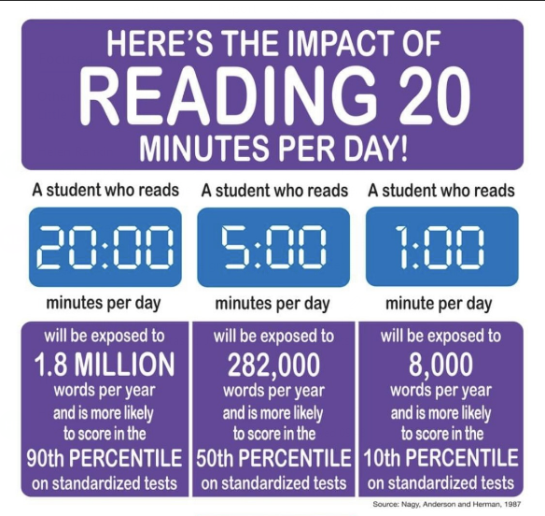
Mathematics and Numeracy
In Mathematics and Numeracy we are following the vision aims of Exploration and Equality.
At Bawdsey CEVC Primary School we believe that all pupils can become confident in key mathematical concepts and be able to apply their skills to a variety of different problem-solving contexts. Our pupils develop an appreciation of the importance of mathematics in everyday life, its application and role in a variety of academic subjects and hopefully an enthusiasm and curiosity about the subject. Enveloping all of this is our fundamental aim of pupils enjoying the subject and approaching reasoning in mathematics with confidence.
The use of concrete, pictorial and abstract representations is fundamental in the teaching of mathematics at Bawdsey CEVC Primary School. The use of concrete resources allows pupils to gain a tangible understanding of a concept first before moving to pictorial representations where they can then demonstrate and apply these further. The ultimate aim is to ensure pupils can use and apply mathematics in the abstract form and apply their skills in a range of problem-solving contexts, making links between different strands of mathematics to embed their understanding. We have recently been exploring a ‘mastery’ approach in maths. Please explore the ‘mastery development’ policy for more information and support regarding our ‘maths mastery’ curriculum.
Maths 2024-2025 plan - Please click on the year for the document. |
Rec | Year 1 and 2 | Year 3 and 4 | Year 5 and 6 |
Maths 2023-2024 plan - Please click on the year for the document. |
Rec and Nurs | Year 1 and 2 | Year 3 and 4 | Year 5 and 6 |
Addition Subtraction Multiplication Division
PROGRESSION STAGES
Links to: Stage 1 Stage 2 Stage 3 Stage 4 Stage 5 Stage 6 Stage 7 Stage 8 Stage 9 Stage 10
|
Intent: Our maths vision has evolved as we have developed our mastery curriculum. In it, we have identified the following Intent: We believe that all children should have: |
|
Implementation: Children work in mixed ability classes, learning the curriculum content of their year group through a variety of engaging tasks and questions. Our goal is to seek mastery of concepts and skills through exploring concrete, pictorial and abstract models. Teachers follow the White Rose Scheme of Learning, which was chosen as it provides small steps guidance to develop varied fluency, problem solving and reasoning tasks. It promotes the use of concrete, pictorial and abstract representations in conjunction with each other and sets a level of challenge for all learners. As a further resource, Classroom Secrets materials, that also have an emphasis upon varied fluency, representations and reasoning, are also used to help with differentiation within the class. Other resources include: NRICH, NCETM, and Greater Depth Maths. Numicon is used school wide as a manipulative to develop a variety of concepts but is used largely in EYFS along with Numberblocks – produced in conjunction with NCETM. Summative Assessments (Rising Stars- PUMA Assessment) used at the end of each term to gain a standardised score against which to track our students against national scores. Objective level data is recorded at the end of each unit to inform teacher assessment and planning. White Rose end of block assessment questions are used to provide summative and formative information about each unit and inform TAs. Staff training has included: Maths Mastery, White Rose (Shanghai method)
|
|
Impact: Our intended impact is that:
|
|
What a typical maths lesson contains:
Classes also teach 15 minutes of arithmetic/times tables per lesson to promote instant recall of number bonds and fact families. Weekly CLIC tests/Weekly times table tests Greater Depths Maths challenges once per half term to ensure all children have access to reasoning and problem-solving questions. |
Science
In Science, we use the PLAN resources, Kapow resource bank and STEM resources for our lessons.
Children learn to question and to ask 'why' and 'how'. They learn to investigate scientific problems, in order to satisfy their curiosity. This includes developing observational skills; acquiring techniques to record their observations; creating and discussing hypotheses; planning and carrying out experiments, and drawing their own conclusions.
.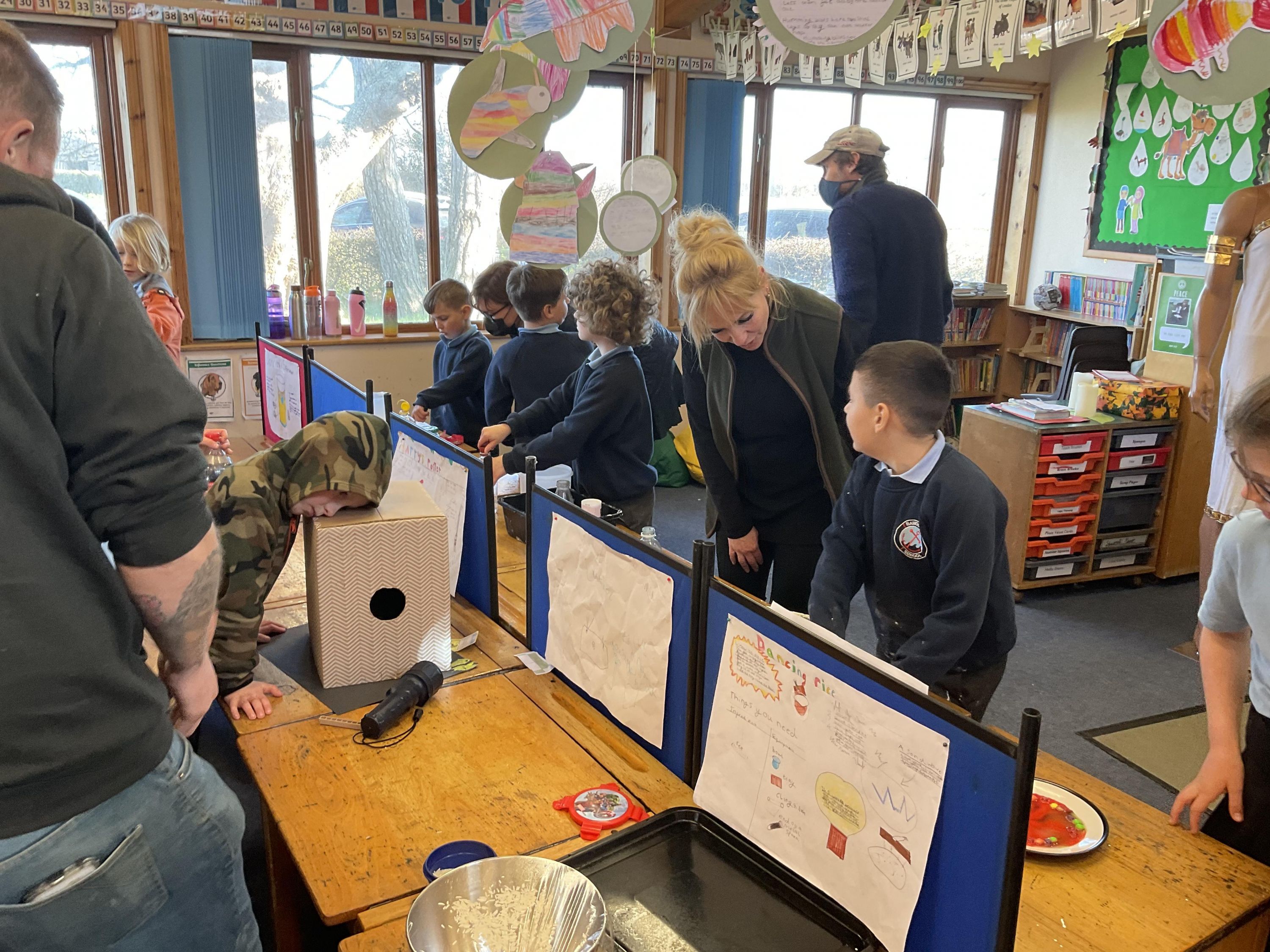
The scientific programme includes studies of plant and animal life cycles using, in particular, local resources such as the school grounds, which includes a wildlife pond, a good variety of native shrubs, trees and insect life and the local fields, hedgerows, verges and seashore.
The programme explores the properties of a variety of different materials; the behaviour of light and sound, electricity and magnetism and the effect of forces and energy. Environmental issues such as saving energy, recycling and the impact of people on the environment are investigated. An understanding of the position of the Sun, Earth and Moon and their movements and influences on Earth, seasons and weather are gained.
|
Intent: Our Science Curriculum enables our children to develop knowledge alongside scientific skills across Biology, Chemistry and Physics. It promotes... ● Curiosity and excitement about familiar and unknown observations. ● Challenging misconceptions and demystifying truths. ● Continuous progression by building on practical and investigative skills across all units. ● Critical thinking, with the ability to ask perceptive questions and explain and analyse evidence. ● Development of scientific literacy using wide-ranging, specialist vocabulary. The scheme of work enables pupils to meet the end of key stage attainment targets in the national curriculum and the aims also align with those set out in the national curriculum. Forest and Beach Schools also allows the children to see Science in the world around them and learn practical applications to what they have learnt. |
|
Implementation: Our Science curriculum is planned to provide opportunities for investigation, both in the classroom in the outside learning environments. Beach Schools and Forest Schools is a valuable vehicle for the exploration and observation of the natural world. In order to meet the aims of the National curriculum for Science and in response to the Ofsted Research review into Science, we have identified the following key strands: ● Scientific knowledge and understanding of: ○ Biology - living organisms and vital processes. ○ Chemistry - matter and its properties. ○ Physics - how the world we live in ‘works’. ● Working scientifically - processes and methods of science to answer questions about the world around us. ● Science in action - uses and implications of science in the past, present and for the future. Kapow Primary’s Science scheme is a spiral curriculum, with essential knowledge and skills revisited with increasing complexity, allowing pupils to revise and build on their previous learning. A range of engaging recall activities promote frequent pupil reflection on prior learning, ensuring new learning is approached with confidence. The Science in action strand is interwoven throughout the scheme to make the concepts and skills relevant to pupils and inspiring for future application. Cross-curricular links are included throughout each unit, allowing children to make connections and apply their Science skills to other areas of learning.
Pupils explore knowledge and conceptual understanding through engaging activities and an introduction to relevant specialist vocabulary. As suggested in Ofsted’s Science research review (April 2021), the ‘working scientifically’ skills are integrated with conceptual understanding rather than taught discretely. This provides frequent, but relevant, opportunities for developing scientific enquiry skills. The scheme utilises practical activities that aid in the progression of individual skills and also provides opportunities for full investigations.
Each year group has an optional exploratory ‘Making connections’ unit that delves beyond the essential curriculum, assimilating prior knowledge and skills to evoke excitement and to provide an additional method of assessing scientific attainment
We use PLAN it resources and ‘Kapow’ for the Science planning and resourcing, alongside a long-term plan made for our unique school by the local Science leader of the PSTT. We use explorify for assessment, ‘Explore, engage and extend’ a PSTT resource and concept cartoons. |
|
Impact: Our intended impact is that:
Meet the end of key stage expectations outlined in the National curriculum for Science. |
|
A typical lesson contains: Recap and recall: Start where children and young people are: find out what they already know, understand, are able to do, and are able to say. Address misconceptions and plan from what is already known. Attention grabber: Something is planned in to attract the pupils attention to the task and focus of the lesson. Main event: Lessons incorporate various teaching strategies from independent tasks to paired and group work, including practical, creative, computer-based and collaborative tasks. This variety means that lessons are engaging and appeal to those with different learning styles. All pupils can access learning, and opportunities to stretch pupils’ learning are available when required. Use of Knowledge organisers for each unit help to identify prior and future curriculum links to make the scheme as meaningful as possible and reinforce key technical terms. Modelled skills and guided experimentation skills are taught to the pupils. Wrapping up: Pupils are given ways to show what they have learnt and reflect on this learning and this is then used in the planning for the next session or unit, and to address misconceptions. |
Religious Education- RE
Religious Education is taught according to the Diocesan Emmanuel resources. Pupils study aspects of Christianity, Islam, Judaism, Buddhism and Hinduism in relation to themes such as celebrations, leaders, rules and stories.
Links to the Emmanuel progression document
|
Intent: Our RE Curriculum demonstrates the commitment we have to providing a breadth of experience and learning around the most prominent world religions. Children learn from and about the key concepts underpinning religion and in so doing come to a deeper understanding of the world and their place within it. They learn about Christianity and the ethos that underpins our practices as a Church School. They also develop their knowledge, understanding and awareness of the beliefs, values and traditions of other individuals, societies, communities and cultures both locally and globally. Through exploration and enquiry, children are encouraged to ask questions about the world and reflect on their own beliefs, values and experiences. |
|
Implementation: Our RE curriculum is built around the Emmanuel Project Curriculum. This programme of study provides a comprehensive approach to learning about the key teachings and messages of Christianity, giving rise to a deeper understanding of the Christian way of life. Learning and teaching about Christianity becomes the firm foundation upon which all other learning about faith, belief and world religions is built. Children meet themes from Christianity, Islam and Hinduism every year, as well as meeting themes from Judaism, Sikhism and Buddhism every two years. They will also encounter Humanism or another non-religious world view during their time at school. In this way, the children engage with a wide variety of different faiths. This learning is complemented by visitors from different faith backgrounds and visits to other places of worship in our local area. Our school maintains very close links with Bawdsey Church and the Just42 organisation, with whom we work closely throughout the year, sharing important celebrations and festivals in the Christian calendar. |
|
Impact: Our intended impact is that:
|
|
A typical lesson contains: Learning is developed through an enquiry cycle in which pupils: • Engage with the key concept in their own lives / world (at least 1 lesson) • Enquire into an aspect of Christianity which relates to the key concept (at least 1 lesson) • Explore a Christian understanding of the key concept through 3 areas (i) Biblical Narrative (ii) Christian Community Practice (iii) Christian Living (at least 1 lesson on each) • Evaluate and Express their learning about the key concept. Or they use the cycle for a non-Christian faith. During these units the pupils are using the key vocabulary linked to the unit and using items from the Knowledge organisers. The pupils’ learning is checked, and any gaps or misconceptions are then used in informing the following sessions. |
Computing (Information Technology IT)
We have an excellent computer suite and interactive smartboard technology, and Key Stage Two children access the Internet to support learning. There is a good library of current, up-to-date software which we use to teach the children keyboard skills. The children are taught how to independently access, use and retrieve their work and to handle information by setting up and using databases. They are also taught to manipulate images, search for information online, send and receive emails and create a musical composition. Programming, debugging and having a working knowledge of algorithms are an integral part of the computing curriculum and provide the children with important life skills.
Internet safety is also an important element of the curriculum as the majority of primary school children regularly use the Internet on laptops, tablets and mobile phones; easy access to digital worlds they can explore without parental/ carer guidance or supervision. We teach the children how to stay safe online and how to use technology responsibly, respectfully, critically and creatively. We also focus on creating a safe online community on Safer Internet Day (annually in February).
With this in mind, here are a few websites to support any parents interested in finding out more about e-safety to help their children. One of the most comprehensive sites for parents is www.thinkuknow.co.uk/parents/ which includes an interactive area especially for children to play games to learn more about e-safety for themselves. The Child Online and Exploitation Protection Centre (CEOP) www.ceop.police.uk/safety-centre/ includes advice about how to make a report if you or your child feels threatened or if they are bullied whilst online. For information about how to set parental/ carer controls and technological advice, visit the parent's page at www.saferinternet.org.uk/ or to watch a short animated film about the ‘Digital Universe of Your Children' you can click on this link www.saferinternet.org/digitaluniverse which makes a good starting point to initiate a family chat about safety online. If you need any help with devices or problems arising online nationally then try www.internetmatters.org/
We use the TEACH computing resources that have been created by the National Centre for Computing Education. teachcomputing.org
|
Intent: Our Computing curriculum aims to reflect the fact that computing and the use of computer technology has become a significant and largely unavoidable part of everyone’s daily life. It is our aim that children are enabled to stay at the forefront of development and change in this area of modern life, inspired and excited about the potential and scope of all that the world of computing can offer. The curriculum is designed to increase the children’s knowledge and understanding of technology and to develop the fundamental and transferable skills required to engage with technology not only in computing lessons, but across the curriculum and in their lives outside of school. |
|
Implementation: We provide children with the opportunity to learn how computers and computer systems work, to design and build programs, to develop their ideas using technology and create a range of content. As part of this, children learn computational thinking, digital literacy and coding which are essential skills for engaging with the digital world. Learning and teaching should facilitate progression through the core strands of digital literacy, information technology and computer science. All of this is underpinned by consistent and continual input on online safety so that children can learn to use computer technology safely, responsibly and respectfully. We follow the DfE recommended computing scheme Teach Computing that has been created by the National Centre for Computing Education. |
|
Impact: Our intended impact is that:
|
|
A typical lesson contains: Teach Computing follows 12 Principles. A combination of these principles will be evident in every Computing lesson.
|
Physical Education- PE
In PE the children have a varied programme of physical activity to develop their physical awareness and abilities. We have a sensible approach to competitive sports, so the children compete in team games very successfully against several other schools in the Farlingaye pyramid as well as in tournaments. We also have a very popular traditional sports day every July.
.jpeg)
We hire 'Xtratime Sports' experts to provide sports and PE to enhance the curriculum. By doing this they are also able to run an after-school club for
the children, which at present there is no charge for. They have also provided more than the usual PE lessons in holding sessions to increase the pupils' experience of sports and dance styles. (Quidditch and 1950s dance was enjoyed by all!)
From our sport grant we use some of the money to cover transport costs, in the few instances when parent/ carer transport is not possible.
At Key Stage 1 the focus is on taught skills with small apparatus and how to create and engage in group games. At Key Stage 2 skills and team games are taught including netball, short tennis, football, rounder’s, hockey, kwik cricket. Outdoor and Adventurous activities include cycling proficiency, tasks set in and around the school grounds and planned use of the Adventure Playground. Dance, both traditional and creative, is an important element of the P.E. curriculum. During the summer, athletics, cross-country and running are part of the Key Stage 2 programme. All Key Stage 2 children also have weekly swimming sessions at the Deben pool in Woodbridge during the autumn and summer terms.
.jpeg)
During the residential visit, children in Years 5 & 6 often take part in activities such as canoeing, abseiling, archery, trapeze, zip line, and assault course. All the children in Years 5 & 6 also complete a comprehensive cycling course held at Bawdsey School, and take part in a cycling and camping weekend when they are in Year 6. We are proud to currently have a Platinum School Games award for all our efforts in promoting sport and making it a lifelong love for the pupils.
Links to progression documents from Complete PE for EYFS and KS1, and for KS2.
|
Intent: Our PE Curriculum is designed to enable children to become physically confident in a way which supports their health and fitness. We provide opportunities to compete in sport and other activities that build character and help to embed values such as fairness and respect. We inspire all pupils to succeed and excel in competitive sport and other physically-demanding activities. |
|
Implementation: We have a platinum award in school sports, and we are a gold-rated healthy school. Our PE curriculum is delivered by class teachers and a team of professional sports coaches from ‘Xtra time Sport’. Through ‘Complete PE’ we use a programme of gymnastics, dance, games and athletics. We encourage children to develop practical skills, physical confidence and the values of fair play and sportsmanship. Children are given the opportunity to develop and hone these skills and attitudes through PE lessons and put them to practical use through a variety of interschool tournaments and after-school clubs. PE and Sport’s Premium Funding is used to enhance the quality of teaching and provision in PE and to increase the opportunities for children to be active. A two-term programme of swimming tuition is provided for all children from year 2 to Year 6 – funded in part by the PE and Sport Premium funding. We also use a local school’s pool for younger year groups to start swimming. We offer a range of sports clubs, such as multi-sports, and athletics for reception to year 6 children. We have developed lots of links with local sports clubs/athletes, so the children are trained by highly skilled people. |
|
Impact: Our intended impact is that:
|
|
A typical PE lesson may contains:
|
Modern & Foreign Languages- French
Children from Year 3 are taught French.
Read fluently
- This concept involves recognising key vocabulary and phrases.
Write imaginatively
- This concept involves using key vocabulary and phrases to write ideas.
Speak confidently
- This concept involves using key vocabulary and phrases to verbally communicate ideas.
Understand the culture of the countries in which the language is spoken
- This concept involves the background knowledge and cultural capital needed to infer meaning from interactions.
Links to the Language Angels resources we use.
French skills progression document ,
French mixed age document explaining teaching and learning
French SEND, PPG and EAL document..
|
Intent: Our French curriculum aims to:
The National Curriculum for languages aims to ensure that all pupils:
|
|
Implementation: All children in classes 2 and 3 will have access to a high-quality foreign languages curriculum using the Language Angels scheme of work and resources. Children will progressively acquire, use and apply a growing bank of vocabulary, language skills and grammatical knowledge organised around age-appropriate topics and themes - building blocks of language into more complex, fluent and authentic language. Our aim is that children have access to authentic resources and experiences of the French language and therefore French lessons are complemented by a variety of materials to maximise curiosity and engagement. |
|
Impact:
|
|
A typical lesson contains: The lesson starts with a welcome in French and a reminder of where French is spoken in the world. The pupils are asked to recall some of their prior learning in French. A discussion around an image, or a game is played, ideas are asked for from the children in English, then the vocabulary given in French for the children to practise. The pupils practice the vocabulary, sometimes recording their ideas. Activities around the four key language learning skills; listening, speaking, reading and writing. Pupils may also learn about the necessary grammar needed for the lesson too. There is often a song about the vocabulary being used. |
History
In History we are using the Kapow resources.
A carefully planned approach to the National Curriculum topics gives children an understanding of time, historical populations, people and events. British history together with European and non-European ancient civilisations are studied. Use is made of the superb historical environment at Bawdsey School so that history becomes meaningful to the children.
Artefacts and visits to places in the villages and historical sites enhance the children's understanding of events and people from the past locally, nationally and internationally. We aim for the pupils to understand how the periods of history are plotted on a global timeline, so they can make links, compare times and identify similarities and differences which have had different impacts on the present in different cultures in the world.
.jpeg)
Links to History progression from Kapow
|
Intent: At Bawdsey, we currently follow Kapow Primary’s History scheme of work. Through faithful adaption, we aim to inspire pupils to be curious and creative thinkers who develop a complex knowledge of local and national history and the history of the wider world. We want pupils to develop the confidence to think critically, ask questions, and be able to explain and analyse historical evidence. Through our curriculum, we aim to build an awareness of significant events and individuals in global, British and local history and recognise how things have changed over time. History will help children to appreciate the complexity of people’s lives, the diversity of societies and the relationships between different groups. Studying history allows children to appreciate the many reasons why people may behave in the way they do, supporting children to develop empathy for others while providing an opportunity to learn from humankind past mistakes. The Kapow Primary's History scheme aims to support pupils in building their understanding of chronology each year, making connections over periods of time and developing a chronologically secure knowledge of history. We hope to develop pupils’ understanding of how historians study the past and construct accounts and the skills to carry out their own historical enquiries. |
|
Implementation: History learning and teaching takes place in the context of an overarching ‘Topic’ and has been mapped out to help pupils to gain a coherent knowledge and understanding of Britain’s past and that of the wider world. Our aim is to inspire pupils’ curiosity to know more about the past, equip pupils to ask perceptive questions, think critically, weigh evidence, sift arguments, and develop perspective and judgement. Through the teaching of history we help pupils to understand the complexity of people’s lives, the process of change, the diversity of societies and relationships between different groups, as well as their own identity and the challenges of their time. When Topic sessions have a History focus, this will be made explicit to pupils so that they can discern the difference between the disciplines of History and Geography. |
|
Impact: Our intended impact is that:
|
|
A typical lesson contains:
|
Geography
We are using Kapow resources in Geography.
In Geography, we teach the children about their own environment, studying the coastline, the villages and rivers, seasons and weather. We compare and contrast this work through visiting urban areas. Children's knowledge of the world in which they live is also extended by studying developing countries. As well as looking at weather, climate, land forms and land use, children learn how and why lifestyles vary around the world.
Links to: Geography progression document from Kapow
|
Intent: At Bawdsey we currently follow the Kapow scheme of learning. Bawdsey’s Geography curriculum of work aims to inspire pupils to become curious and explorative thinkers with a diverse knowledge of the world; in other words, to think like a geographer. We want pupils to develop the confidence to question and observe places, measure and record necessary data in various ways, and analyse and present their findings. Through our scheme of work, we aim to build an awareness of how Geography shapes our lives at multiple scales and over time. We hope to encourage pupils to become resourceful, active citizens who will have the skills to contribute to and improve the world around them. |
|
Implementation: Geography learning and teaching takes place in the context of an overarching ‘Topic’ and has been designed to spark interest and inspire in pupils an enduring curiosity and fascination about the world and its people. The curriculum will develop pupils’ knowledge about diverse places, people, resources and natural and human environments, together with a deep understanding of the Earth’s key physical and human processes. They will also engage with their own locality, understanding the key human and physical features of this environment and make comparisons with the world as a whole. They will note how these features are interconnected and how they change over time and develop an understanding of human influence over this change. As part of this learning, they will develop the skills needed to analyse data and how to interpret and communicate geographical information. When Topic sessions have a Geography focus, this will be made explicit to pupils so that they can discern the difference between the disciplines of Geography and History. |
|
Impact: Our intended impact is that:
|
|
A Geography lesson contains: A review of prior learning Adaptive teaching A strong focus on developing both geographical skills and knowledge Critical thinking Collaborative Practice Geographical vocabulary Fieldwork opportunities Map skills (using the eight-points of a compass, four and six-figure grid references, symbols and keys on maps, globes, atlases, aerial photographs and digital mapping). Opportunities to compare localities Reflective practice |
Music
|
Music in school is not restricted to standalone sessions. Each assembly features a hymn, promoting strong links to the school’s Christian ethos. Carefully selected pieces of music from a variety of genres are played each week in assembly to promote diversity within school. We also have a school song, composed specifically for pupils linked to our values. We use the Kapow resources, Links to Music progression document from Kapow |
|
Intent: Our music curriculum aims to:
The National Curriculum aims for all pupils to:
|
|
Implementation: Children have a variety of opportunities to sing, listen, create, play, perform and evaluate. This is embedded in classroom activities and lessons as well as weekly singing assemblies, various concerts and performances, the learning of instruments and partnerships with outside agencies, including the Suffolk Music Hub. Music lessons are planned to provide children with the opportunities to review, remember, deepen and apply their understanding. It is also developed to ensure an appropriate level of challenge for all learners in our mixed age classes. Pupils need to experience a rounded music curriculum, including listening and appraising and the basics of notation, to enable them to succeed at secondary school and as future musicians. We assess using Pupil Asset objectives from the National Curriculum. We use the Kapow curriculum within the school, their five individual strands are woven together to create engaging and enriching learning experiences:
Each unit combines the strands within a cross-curricular topic designed to capture the pupils’ imagination and encourage them to explore music enthusiastically. Through the Kapow resources the children will be taught how to sing fluently and expressively and play tuned and untuned instruments accurately and with control. They will learn to recognise and name the interrelated dimensions of music- pitch, duration, tempo, timbre, structure, texture and dynamics- and use these expressively in their own improvisations and compositions. |
|
Impact:
|
|
A typical lesson consists of: Learning will incorporate a range of teaching strategies from independent tasks, paired and group work as well as improvisation and dance elements, as well as making cross curricular links with other areas of learning. Lessons which support and extend all children in their lessons. Use of Knowledge organisers. A foundation of factual knowledge being taught with encouraging the recall of key facts and vocabulary by the children. Lessons may have listening to music and their thoughts are encouraged to describe the music. Recreating the music, vocally or with tuned or untuned instruments. Creating their own music and recording the notation for it. Performing their music and discussing the music made. |
Art

In Art children are taught to develop their knowledge and skills in drawing, painting, print making, collage, three-dimensional work and design in a variety of media including textiles and clay. Children begin with experimenting with colour, pattern, texture, shape and form. They are introduced to and taught different media skills and techniques throughout their primary years. The children develop an appreciation of their cultural heritage by studying the work of artists throughout time and from different cultures.
Link to Art ;prgression document from Kapow
|
Intent: Our Art and Design curriculum aims to inspire pupils and develop their confidence to experiment and invent their own works of art. The subject gives pupils every opportunity to develop their ability, nurture their talent and interests, express their ideas and thoughts about the world, as well as learning about art and artists across cultures and through history, as well as locally. They will interpret and reproduce their own versions of these works. Opportunities for self-expression and the acknowledgement and appreciation of the artistic expression of others are fundamental to our intent for this subject. |
|
Implementation: Children are also introduced to the work of ‘great artists’, encouraging pupils to be inspired, think critically and develop a fuller understanding of art and design. They will develop a greater understanding of the links between art and design and the history, culture and creativity of our nation. Five strands run throughout each year group.
Units of lessons are sequential, allowing children to build their skills and knowledge, applying them to a range of outcomes. The formal elements, a key part of the National Curriculum, are also woven throughout units. Key skills are revisited again and again with increasing complexity in a spiral curriculum model. This allows pupils to revise and build on their previous learning. Units in each year group are organised into four core areas:
Creativity and independent outcomes are robustly embedded into our units, supporting students in learning how to make their own creative choices and decisions, so that their art outcomes, whilst still being knowledge-rich, are unique to the pupil and personal. |
|
Impact: Our intended impact is that:
|
|
A typical lesson contains: Lessons are always practical in nature and encourage experimental and exploratory learning with pupils using sketchbooks to document their ideas. Support and extension ideas are available, so all children can access the work. Knowledge organisers will be used to show the key knowledge and techniques learned, encouraging recall of skills processes, key facts and vocabulary. Pupils may be learning about great or local artists and the historical and cultural development of their art. |
Design & Technology
All pupils are taught to identify and plan designs through investigations for specific needs. During their time at Bawdsey School children work with fabrics, wood, recyclable materials and construction sets.
Link to D and T progression document from Kapow
|
Intent: Our Design and Technology curriculum inspires pupils to be innovative and creative thinkers who have an appreciation for the product design cycle through ideation, creation, and evaluation. We want pupils to develop the confidence to take risks, through drafting design concepts, modelling, and testing and to be reflective learners who evaluate their work and the work of others. We aim to inspire children and young people to create, experience, and participate in great arts and culture. |
|
Implementation: The Design and technology National curriculum outlines the three main stages of the design process: design, make and evaluate. Each stage of the design process is underpinned by technical knowledge which encompasses the contextual, historical, and technical understanding required for each strand. Cooking and nutrition has a separate section, with a focus on specific principles, skills and techniques in food, including where food comes from, diet and seasonality. Cooking and nutrition is given a particular focus in the National curriculum and we have made this one of our six key areas that pupils revisit throughout their time in primary school:
Each year each class have lessons on cooking healthy meals and snacks too, often using our own produce and so the children learn cooking and preparation skills and the basis of being healthy. Children also learn woodworking and other skills in Forest School and Beach School sessions each year. |
|
Impact: Our intended impact is that:
|
|
A typical lesson contains: Lessons incorporate a range of teaching strategies from independent tasks, paired and group work including practical hands-on, computer-based and inventive tasks, which appeals to different learning styles. Support and extension ideas are available, so all children can access the work. Knowledge organisers will be used to show the key knowledge and techniques learned, to support pupils in building a foundation of factual knowledge by encouraging recall of key facts and vocabulary. |
Cookery
|
In Design and Technology- cookery, We are now able to teach the children how to prepare and cook healthy meals in our teaching kitchen. This helps promote our values of 'resilience' and 'exploration' as children learn new skills. The cooking area allows us to teach the children how to be healthy and look after themselves. They will be able to cook frequently and use the vegetables and fruit that the children grow on site. The teaching kitchen will also promote 'resilience' as children will be taught the importance of keeping healthy bodies and healthy minds. |
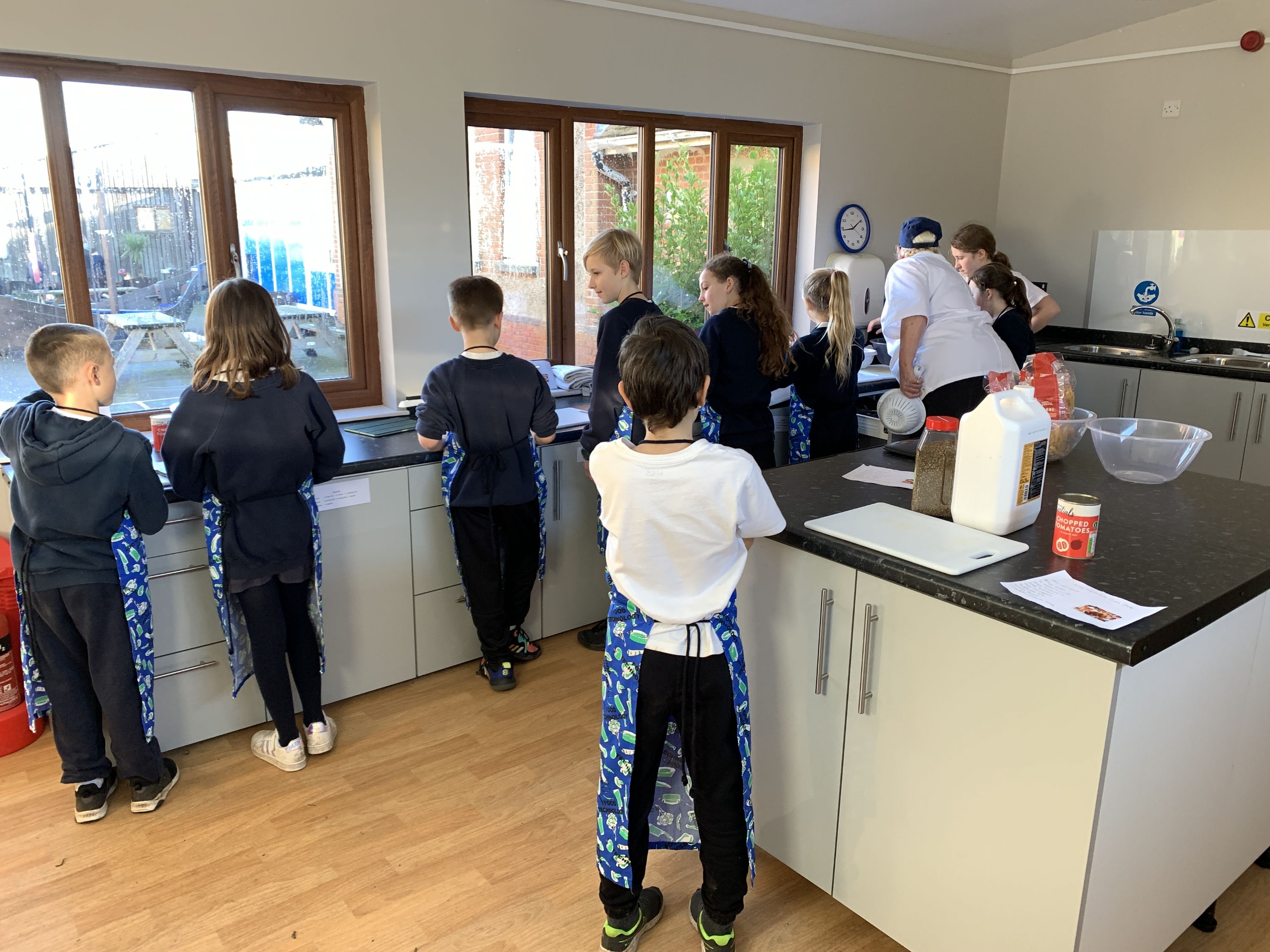 |
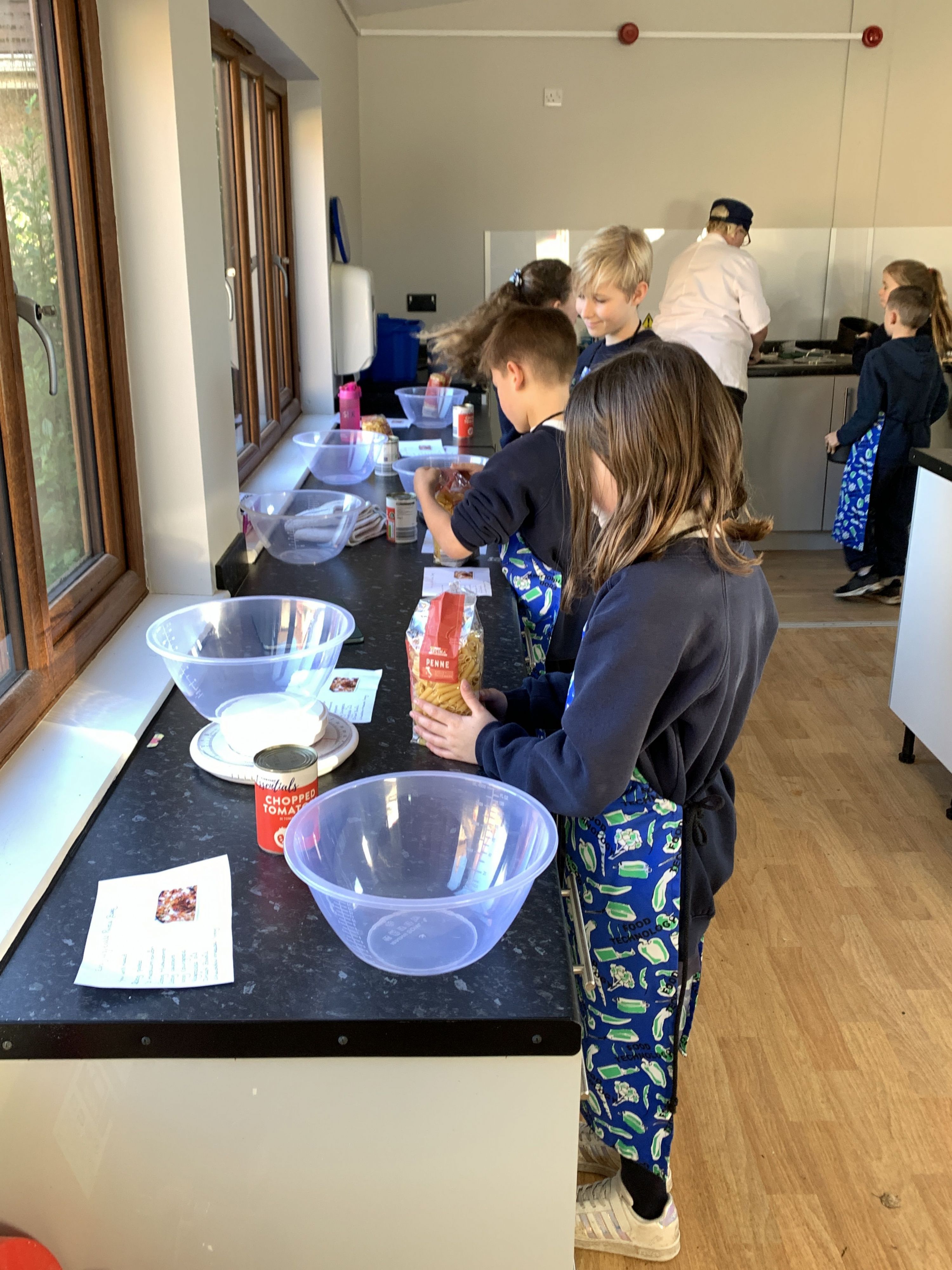 |
PSHE -Personal, Health and Social Education & Citizenship RSE- Relationship and Sex Education
Relationship and Sex Education (RSE) is often taught across the curriculum through other subjects and topics where links can be naturally made. Our school values of: Equality, resilience, courage, exploration and caring are embedded throughout the school and these will incorporate many objectives from our RSE planning. RSE is also taught discreetly through PSHE sessions. Beginning in early years with ‘pantosaurus’, over many years the school has successfully taught a program of Sex Education to ensure pupils are prepared for life. This builds on the RSE Relationship planning and is brought in during Year 5, when puberty is taught in more detail, and in Year 6, when we teach how babies are made and how they are born. Parents/ Carers have the right to request their child is removed from these sessions.
The RSE curriculum covers five specific objectives: To ensure pupils know about
1) Families and people who care for me
2) Caring Friendships
3) Respectful Relationships
4) Online Relationships
5) Being Safe.
Class PSHE sessions are always representative of the cohort and may be adapted to meet any specific cohort need.
We also provide additional pastoral support for children using additional resources such as: reflection corners in the classroom, Lego Therapy and mindfulness activities in each classroom. This year we encouraged mental health awareness on World Mental Health day and enjoyed a yoga session that taught us important breathing techniques. We use Thrive throughout the school to help with children's mental health and wellbeing development.
|
Intent: Our PSHE Curriculum enables children to develop the skills, attitudes and qualities needed to become healthy, independent and responsible members of society. It explores the concept of self and key elements of this, such a mindset and outlook, encouraging resilience and self-reflection with the aim of empowering children to take care of both their physical and mental well-being. The curriculum aims to help children understand how they are developing personally and socially, and tackles many of the moral, social and cultural issues that are part of growing up. Children learn about rights and responsibilities and learn to understand and appreciate what it means to be a member of a diverse society. Children are encouraged to develop their sense of self-worth by playing a positive role in contributing to school life and the wider community. |
|
Implementation: Our PHSE curriculum is delivered using OneDecision and Twinkl resources as a starting point for most areas of the curriculum. We are also using the No Outsiders scheme of learning to promote inclusivity and acceptance. Additional published resources are used to supplement this scheme such as those available through the PSHE Association. Collective Worship, Circle Time, discussions and reflections are an integral part of learning experiences, enabling children to explore key concepts and share their views. |
|
Impact: Our intended impact is that:
|
|
A typical PSHE lesson contains: The 1decision resources have been built around the above three core themes, and the 10 principles of effective PSHE education, which are as follows: 1. Start where children and young people are: find out what they already know, understand, are able to do, and are able to say. For maximum impact, involve them in the planning of your PSHE education programme. 2. Plan a ‘spiral programme’ which introduces new and more challenging learning, while building on what has gone before, which reflects and meets the personal developmental needs of the children and young people. 3. Take a positive approach which does not attempt to induce shock or guilt but focuses on what children and young people can do to keep themselves and others healthy and safe and to lead happy and fulfilling lives. 4. Offer a wide variety of teaching and learning styles within PSHE education, with an emphasis on interactive learning and the teacher as facilitator. 5. Provide information which is realistic and relevant, and which reinforces positive social norms. 6. Encourage young people to reflect on their learning and the progress they have made, and to transfer what they have learned to say and to do from one school subject to another and from school to their lives in the wider community. 7. Recognise that the PSHE education programme is just one part of what a school can do to help a child to develop the knowledge, skills, attitudes and understanding they need to fulfil their potential. Link the PSHE education programme to other whole school approaches, to pastoral support, and provide a setting where the responsible choice becomes the easy choice. Encourage staff, families and the wider community to get involved. 8. Embed PSHE education within other efforts to ensure children and young people have positive relationships with adults, feel valued and where those who are most vulnerable are identified and supported. 9. Provide opportunities for children and young people to make real decisions about their lives, to take part in activities which simulate adult choices and where they can demonstrate their ability to take responsibility for their decisions. 10. Provide a safe and supportive learning environment where children and young people can develop the confidence to ask questions, challenge the information they are offered draw on their own experience, express their views and opinions and put what they have learned into practice in their own lives. |
Pupils with Special Educational Needs and/ or Disabilities
If a child has additional needs, we provide work and opportunities to address these and make reasonable adjustments, so they are fully included in the whole curriculum. Gifted and talented children, as well as those with academic differences, those who do not speak English as their first language, and those who have physical disabilities, are all welcomed into our school and given assistance relevant to their needs. The small class sizes enable this to take place. Bawdsey School also prides itself on the regular support which is provided for children with special needs and/ or disabilities. Sessions providing carefully structured programmes of work for a range of differences are a feature of the school. The progress of these children is regularly monitored for impact in the pupils' learning.
At all stages parents/ carers are fully consulted, and regular meetings held with the teachers working with the individual child.
